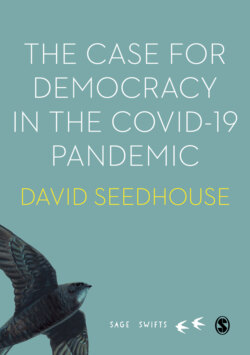Читать книгу The Case for Democracy in the COVID-19 Pandemic - David Seedhouse Dr. - Страница 10
На сайте Литреса книга снята с продажи.
About this Book
ОглавлениеThis book has a simple theme and structure, anchored in a troubling dichotomy between certainty and uncertainty. The most striking element of the COVID-19 pandemic has been the confidence of governments in their measures, when almost everything is highly uncertain and much – including knowing whether the measures will work – is just not known. This incongruity is reflected in several other imbalanced dualities, for example, science versus community values, risk management versus civil liberties, epidemiological modelling versus the modelling of broader social consequences, and paternalistic enforcement versus informed consent.
To provide a map through the mass of issues raised by the pandemic, the dualities are referenced throughout the book.
The questions embedded in every aspect of this episode are: why do human beings act as if we know what we are doing when we plainly do not? Why do we find it so difficult to admit our lack of knowledge? How is it that we repeatedly fail even to recognise our ignorance? The book addresses these questions, to try to put people's reactions to the crisis in some sort of perspective.
Most of the dualities are considered carefully. It is suggested that those on the right of the list (mostly the uncertainties (B)) should be recognised as at least equally important as those on the left (predominantly the certainties (A)). For example, while science is a powerful tool it cannot drive decision-making in a value-free way; while journalism is vital to keep citizens informed it should be investigative and open-minded and never slide into propaganda; and while disease can be a major problem, tackling it cannot sensibly be done to the exclusion of all the other problems we face as human beings.
The initial discussion of certainty versus uncertainty is focused on samples of planning documents and minutes of advisory committees which informed the UK government's decision-making. This material shows that the government's response was based on ‘best guesses’ about what might happen, from a wide range of different possible scenarios, and was single-mindedly centred on dealing with the virus. Despite pervasive uncertainty, reflected in the documents themselves, extremely assertive actions were taken, echoing similar and even more severe policies favoured by other nations.
It is impossible to think about the response to the pandemic without noticing pervasive psychological distortions. These are explained in a basic fashion, to highlight various biases that have altered our perceptions of so many facets of normal life, not least our perceptions of risk, which have been amplified out of all proportion.
With rare exceptions, ethics has been absent from media debate. This is hard to understand, not least since public health is a branch of medicine and medical ethics is normally a powerful regulator of interventions on individuals and groups. Why this has been so overlooked is mystifying. Consequently, a fair-sized section is devoted to this subject, and leads to the final part of the book, where the case for democracy is outlined.
In sum: massive decisions have been taken in the interest of public health without the involvement of the public; these decisions have been based on often highly distorted perceptions of reality; these distortions have partly arisen from a collective belief that ‘we must battle the virus at all costs', which has been constantly reinforced by a deluge of scary tales in the press, and further bolstered by unequal attention to more considered reflections. These factors, and more, underpin the book's argument for inclusive, participatory democracy: if the main problem has been an overly narrow focus on a few dominant elements, led by a handful of like-minded decision-makers, an obvious alternative is to broaden decision-making to include diverse voices, knowledge, values, experiences and cultures – as a practical, effective way to make policy.
The Case for Democracy not only explains why this is so desperately needed, but also gives examples of many existing inclusive, democratic initiatives around the world. Wide-reaching participatory democracy is already happening. While it will be a challenge to extend these examples to involve many thousands of us, it is by no means impossible. It can and must be done.
